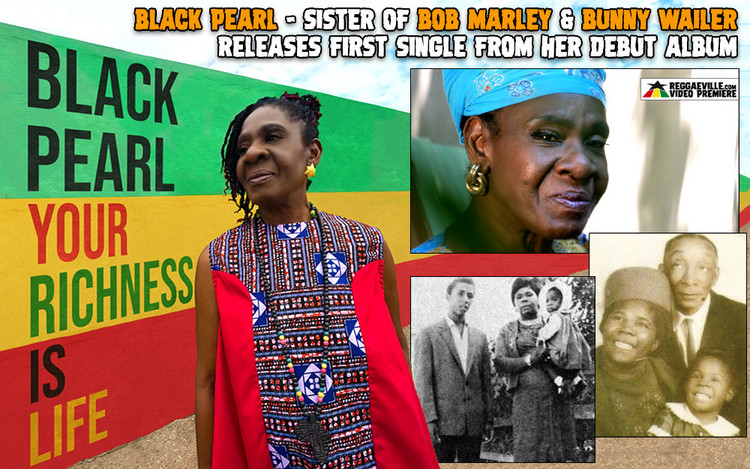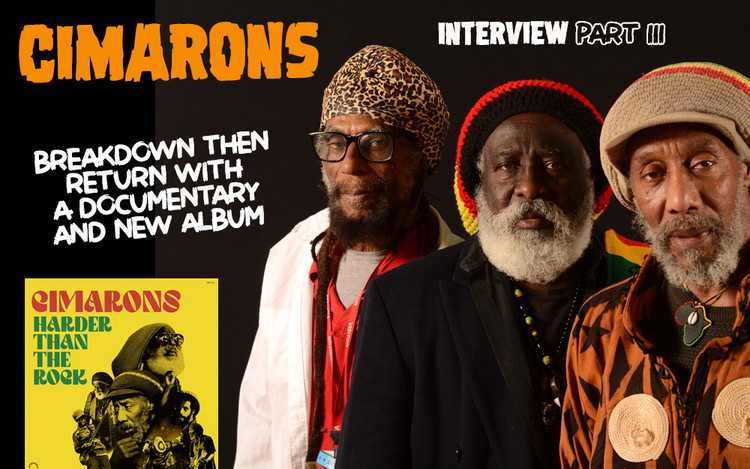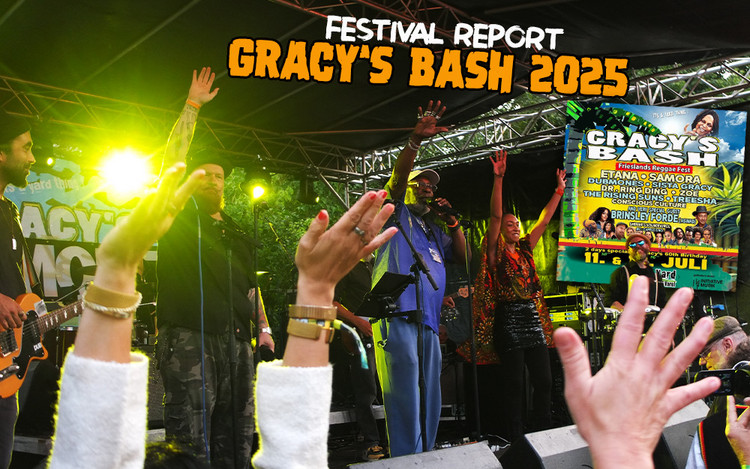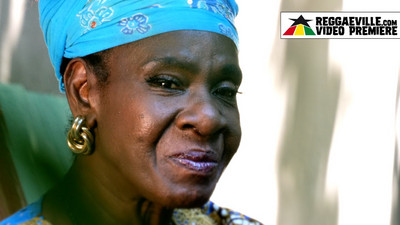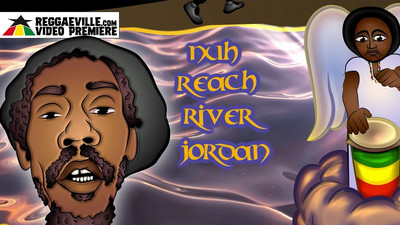Roger Steffens ADD
Interview #2: Roger Steffens About His Reggae Archives
04/28/2013 by Larson Sutton
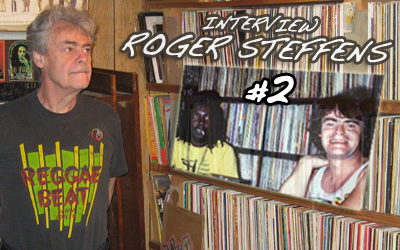
If Bob Marley is reggae’s prophet, Roger Steffens is the one chiseling prophesies into stone. As witness and participant, journalist and fan, teacher and student, Steffens, 70, has immersed himself in the world of reggae for the past 40 years. His personal collection-turned-archive contains tens of thousands of pieces from all over the globe, and is now seeking a new home. We caught up with Steffens following his show-opening appearances on the Wailers Band’s month-long Survival Revival tour. Here is part two of a two-part interview:
Did you collect things as a child?
I’ve always been a collector. My sixth birthday my mother gave me her big, thick Scott stamp album. I was fascinated by stamps in the 1940s. I learned history, geography, and current affairs from it. It was a great hobby. I still, to a lesser extent, collect interesting stamps but not with any great passion or completeness anymore. I’m always looking for interesting stamps to this day. At the age of 10, I was fascinated, in 1952, by flying saucers. A comic strip started in New York called Twin Earths. It said that the saucers came directly from a planet on our own orbit, but directly opposite so it was forever hidden by the sun. It was called Terra, that was where the saucers came from, and the population was 92% female. All voluptuous. And I was 10. Shortly after I started cutting it out of the newspaper everyday I wrote a fan letter to the artist Alden McWilliams. He sent me back five original drawings and a three-page handwritten letter. We were friends for the rest of his life. I still have thousands of those strips in a drawer in the back room. He used to put my name in the strip when I was a kid.
And music?
I was always interested in music. I bought my first records, they were 78s, in 1954. “Sh-Boom” by the Chordcats and “Rock Around the Clock,” the first release of it by Bill Haley and the Comets. I worked in a supermarket all through high school so I had a lot of money to spend. Every Friday when I got paid I would go to the little record store and buy the latest hits. I was really into doo-wop. I went to Alan Freed’s Rock and Roll shows beginning in ’57, the live shows. I still have every record I ever bought since 1954 worth keeping.
As a young person, did you treat your records with the care of a collector?
Absolutely. They weren’t taken out of the sleeve and piled in the corner. I always took immaculate care of my own records.
What do you think drove you to keep things?
In 1960 I was the New Jersey state oratory champion. I’ve always been a public speaker, and I’ve always been a writer. Whatever subject interests me, I always keep a file on it because I may someday write or speak about it.
When did you discover reggae?
In 1973 after the conglomerates had bought all the major record companies and de-fanged them, I, like a lot of other people, was looking for a music that would reignite my interest. I found an article in Rolling Stone that summer that turned me on to reggae by Michael Thomas called The Wild Side of Paradise. I went out that night and I found a used copy of Catch a Fire for $2.25 in Berkeley. I had never heard anything like that in my life. It had the harmonies of the great doo-wop groups that I loved and it had the political understanding and commitment of the great ‘60s music. The next night I saw The Harder They Come and bought the soundtrack on the way home, and my life has been on a reggae trod ever since. A total different direction from anything that had happened before.
Did you think then to collect reggae items?
I had a manila envelope and I put that issue of Rolling Stone in the manila envelope. As I look back now with a 40-year vantage point, I realize that was the birth of Roger Steffens’ Reggae Archives. Everything I came across having to do with reggae, no matter how minor, got put in a file. We’ve had to move twice now to house the collection. We just burst two houses and, as you can see today, we are close to bursting out of this one, too.
Maybe it’s semantics but what you could call it a collection, an archive…
Or hoarding. (laughs)
Did you know you were building an archive as you collected?
Not immediately. It took several years. I met Hank Holmes in 1978 who had a phenomenal reggae collection and never left L.A. in his life. We tried for a year to get on the radio and finally got on KCRW in ’79. So, I actually started having records sent to me. I had a special interest in Bob Marley. I tried to find everything I possibly could about him. When Stephen Davis and Timothy White were researching their early biographies of Bob in the immediate aftermath of his passing, they both came to me. Both of them, in print or otherwise, said their books wouldn’t be possible without access to my archives. Timothy wrote that in his Catch a Fire book. That’s the first time I ever heard the word archive used for my collection. By that time we had already started a television show with Chili Charles. In ’82, CC Smith and I started a magazine initially called The Reggae Beat, which was the playlist for the radio show and just kept growing and growing like Topsy. All of these things led to more input from various sources. I kept everything. Every press release. Every autographed record. I was much more serious about it by ’81. I realized that this was a valuable repository that could be of use to writers and others. I embraced that being a writer, myself, and realizing how important it is to have somewhere to go to find out the truth about your subject.
What’s the balance between items of personal importance and historical importance?
Everything is important to an overstanding of reggae and its position in the world, especially in the internationalization. These cabinets are filled with 30,000 reggae flyers from all over the world. I love to document the spread of it to places like Tuva up by Mongolia and to the bottom of the Grand Canyon with the Havasupai. This is all part of the bigger story of Rasta’s influence in the world. I’m into roots music, Rasta music. Everything is important in terms of research, and a lot of these things are very important to me personally. The things that Peter Tosh signed for me. The poster that has all the signatures of the most important people in Bob’s life. When I loaned that to the Grammy Museum for their Marley exhibition last year, they insured that poster for $75,000. It’s hard to differentiate. I treasure it all. Everything has a personal memory for me.
If not for reggae coming along in 1973, do you think some other subject in your life could or would have been served by your collecting interest, perhaps resulting in a similar archive, or was there something about reggae that demanded you to collect and accumulate to this degree?
Fascinating question, one I've never considered. Without reggae where might my life have gone? I suppose it would have continued in the acting phase of my life. I came to Hollywood in 1975 to pursue a film career, abetted by screenwriters Waldo Salt and Bill Link. I got into SAG almost immediately with roles on Bill's Ellery Queen TV series and his movie, Rollercoaster. Perhaps I would have begun collecting movie scripts. But music has always been my life's prime delight, and maybe African riddims would have taken over my interests. I had been into that continent's music since 1958 - Olatunji, Miriam Makeba, Hugh Masakela, Fela - and I might have ended up doing an African music radio program sooner than "Morning Goes Makossa" which ran on KCRW from 1980 to 1984. But as I look back, I don't see anything else I've encountered that ignited the collectors' instinct in the rich way that reggae and Rasta
have. There was too much creative diversity in it to be easily pinned down; every part of the puzzle revealed more of its mysteries. I remember wondering aloud to my partner Hank Holmes back in the early '80s if I would ever feel sated. I have now reached that point after 40 years of collecting - although I add more to the archives daily. My obsession has been richly rewarded, opening avenues I never in my wildest imaginings would have considered possible. Thank you, Jah.
Ideally, what would you like to have happen to the archives?
I want it institutionalized. USC is interested in it, but they haven’t been able to come up with any money. I want it all to be available to the public while respecting all the rights of the artists. I absolutely demand that it be kept intact forever. Without those two provisions it will never leave this house. But, it has to leave this house. It belongs to the world. Three, four days a week there are people like you coming here to see it and use it as a research tool for various projects. There are scores of books that have been written with the help of this archive. It shouldn’t be in a basement in Echo Park in Los Angeles. It should be at a college or a museum.
What exactly is preventing that?
Someone with the money and the vision to carry it through. We tried recently through a Kickstarter campaign that a very ambitious woman in Jamaica named Chazz has put together. She wants to build a museum on property she owns up near Nine Mile. She has a wonderful plan for the building, has been here to see the archives, and is convinced this is an instant museum that Jamaica could make tremendous money off, and also educate its own people. Jamaicans in many ways are very insular. They don’t realize how far their music and culture has reached. They don’t truly overstand the internationalization of it. My collection goes back to the earliest days of ska, but it also reaches out to all the continents on Earth. To have that all in one place would be a remarkable boon to Jamaica’s economy and to Jamaica’s intellectual life. That remains my omnipresent goal.
Should that day come, what will you keep?
I have to willing to part with everything.
Everything?
It has to all go. Every last scrap of paper.
Nothing you’d keep?
I can’t.
Why?
Because I’m 70 years-old. How much longer am I going to live? I can’t take it with me.
You have children.
Yes, but they don’t have the same value for it.
Isn’t there something you’d want to keep until your last days?
Everything has to go.
Did you arrive at that decision…
Reluctantly? Once I start cherry-picking where do I stop? I’ve been guided, oddly enough, by Howard Dodson, who is the head of the Schomburg Intstitute of the New York Public Library in Harlem, who tried to buy this back in 1987. He said, ‘What do you do with your fan mail?’ I said I answer the ones that need answering and I throw the rest away. He was aghast. He said, ‘Oh, my God. Don’t do that.’ I said, ‘Why?’ He said, ‘Because it documents the spread of a culture. How did this little Caribbean island with its music made only in western Kingston suddenly become a worldwide influence. That’s what all these correspondences document for historians.’ The ephemera, he said, the posters, the flyers, a hundred years from now will be worth their weight in gold. Those three huge cabinets are filled with correspondences from all over the world, from people involved in reggae music. From Bolivia, Poland, Australia, Japan, South America. 30,000 flyers from all over the world. I think the hardest thing to part with, now that I think about it, would be all my own writings. All the tear-sheets of all the magazines, the newspaper articles I’ve done over all these years because that is the most personal. I’ll probably Xerox some of them or scan some of them.
Did you have any sense that this is what your collection was to become- a world-renown archive?
No, never. I never set out to do anything like this. This was just a gradual accretion over the years.
When did you start thinking about it going away?
In ’87 when the fellow from the Schomburg flew out to see it. It was right after I quit the Reggae Beat.
How much has it grown in the 25 years since you decided you wanted to pass it on?
1,000%.
So once you’d resolved to pass it on, you still accumulated things?
To this day. I’ve got all those buttons over there by Pa Glen that just came in. I’ll get something in the mail today. I just got a bunch of books from France a couple of days ago. When I was in Washington on the Survival Revival Tour, Doctor Dread from RAS Records deaccessioned a lot of his own library and gave them to me for the archives. People now are dying and leaving me their collections, like Geoff Cooper did. Geoff made professional recordings of seven golden years of Sunsplash in Jamaica, from 1982 to 1988 and left me the tapes and digital masters, plus 500 albums and 600 singles. I feel a tremendous responsibility to keep that intact, and keep it as part of the overall gestalt of the reggae archive so that all of these other people’s life’s work will be treasured as strongly as I treasure my own.
How often, just for enjoyment, do you randomly pick a tape and listen to it?
Every day. I like to just grab a drawer, not look, and pull out a tape. I still sell some of the old Reggae Beat radio shows on my reggaesupersite.com. It gives me a chance to revisit those shows because I have to digitize them in real-time; listen to see if the tape is still working. That is always fun.
Anything lately surprise you?
I just recently listened to, and I don’t mean to be boastful, but an extraordinary interview with Yabby You and Albert Griffiths of the Gladiators that I’m going to turn into an article for Reggae Vibes magazine in France. I hadn’t listened to that in 29 years. He only went out on the road once. We had a four-hour, non-commercial show every Sunday afternoon where we could do anything we wanted. We could just play music for four hours or we could talk for four hours. He was a great, great talker, and a unique speaker, because he was a Jesus Dread. He explained his philosophy in great detail. I was mesmerized listening to this thing. We had virtually all the major figures. We started with Bob Marley, for Lord’s sake. Tosh was on. Bunny. Jimmy Cliff. Culture, and Spear. Everybody. That’s a valuable historic resource. 400 Sundays. 1,400 hours of oral history. It was like a graduate course in reggae for the city of Los Angeles, and eventually the world when they syndicated it to 130 stations including the Voice of America Africa service, so it was heard all over Africa. A guy from Poland who I met with two years ago when I went to Poland to play there, came over about 23 years ago and camped out in the living room for five days and nights and never went to sleep. He went home with 75 cassette tapes and played them on the Polish national radio station. For a while I was getting all these fan letters in Polish that I couldn’t understand. Roger’m Steffens’m. The show had an effect, especially through the magazine.
How much of the archive is backed-up somehow?
A lot. Not so much the three-dimensional stuff, but the music. A lot of radio shows. Certainly all the Marley specials. There is a good deal of it in digital form, and there is a lot of stuff I created myself initially in digital form. Everywhere I go I photograph people wearing Marley clothing. Now there are over 5,000 shots in digital form, plus 3,000 snapshots, prints. I have always wanted in the museum to have a huge wall with all those pictures with a name of the city or town where they were shot on each picture so that people could come to the museum and find themselves.
Is it necessary to have nothing left because anything kept would be a reminder of the whole? Like a catharsis?
If I sell it, the first time I go looking for that rare Alton Ellis single that I always love to play and it’s not here anymore, that’ll hurt.




